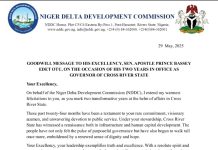
By Eyizle Ene-Okon
Imagine a world that would be free from unnecessary moist accumulation, where Water actually bounces off a surface and rolls away, which will often liberate metals from the adverse effect of rust, wear and decay.
More credits goes to an innovative laser project of The Rochester University scientists Chunlei Guo and Anatoliy Vorobyev which have developed a technique using extremely precised laser patterns that renders metals superhydrophobic: in other words, incredibly water-repellent capacity.
The possibilities are many, Guo says. Kitchenware, of course. Airplanes: No more worrying about de-icing, because water won't be able to freeze on aircraft in the first place.
And sanitation in poor countries, an idea close to the heart of the Bill and Melinda Gates Foundation, which helped fund the project. Thanks to the surface's repellent properties, it's essentially self-cleaning.
Ironically, Guo was inspired by a project in which he and a team treated a variety of materials to make them superhydrophilic — that is, water-attracting.
"We worked with a variety of materials — not just metal but semiconductors, glass, other things," he said. Even on a vertical surface, "the effect was very strong. If I drop a drop of water on the bottom of this surface, it would actually shoot up against gravity, uphill. So that really motivated us to look into this reverse process."
In their paper, the two compared the surface to that of a lotus leaf, which has "a hierarchical structure containing a larger micro-scale structure" and is superhydrophobic.
"Our structure sort of mimics, in some way, this natural (arrangement) of the lotus leaf," Guo said.
And like the lotus leaf, because the laser-patterned metal is so water-repellent, it has self-cleaning properties. In an experiment, Guo dumped some household dust from a vacuum cleaner on a treated surface. Just a few drops of water collected the dust, and the metal remained dry.
In their work, the scientists used platinum, titanium and brass as sample metals, but Guo says he believes it could work for a wide variety of metals — not to mention other substances.
The process is still very much of the lab. It took the scientists an hour to treat a 1-inch-by-1-inch sample and required extremely short bursts of the laser lasting a femtosecond, or a millionth of a billionth of a second.
But Guo is optimistic about ramping up the process for industrial use, and he says the goal for the sanitation project is to "really push the technology out" in the next two or three years.
And then?
"I do believe down the line we will be able to make it accessible to everyday life," he said.
Watch out, water.









